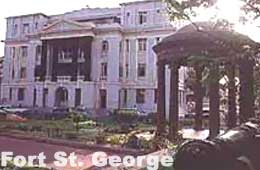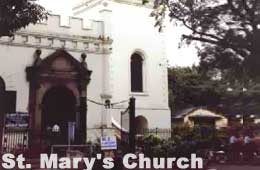| India Profile » Monuments and Temples in India » Fort St. George, Tamil Nadu | |
Fort St. George, Tamil Nadu | |
 | |
|
The city of Chennai is divided into 3 parts. River Kayum creates the boundary on the north of George Town, i.e., Fort St. George or the administrative and commercial complex of the city. The Paris Corner is on the right side of the city. It is the busiest section of the city. Chennai Central lies between River Kayum and River Adiyer. Mayalpur, an old Portuguese colony is towards south. Fort St. George marks the beginning of development of Madras (Chennai) as a modern city. It looks more like a complex of the well-maintained colonial mansions then a fort. It houses a place where Lord Clive - the establisher of British rule in India used to live. Fort St. George houses the tallest towering flagstaff in India. The building had been constructed in a typical English style of architecture of the 17th and 18th century AD. It has beautiful stained glasses, church benches made of teak, ornate marble walls, frescoes and plaques. A moat was built around the fort to keep the locals at a distance. It once housed the British regiment mess and later the lighthouse. The fort houses St. Mary's Church and Fort Museum. St. Mary's Church the oldest Anglican church in India. It was built in 1678-80 AD. The tombstones in its courtyard are the oldest British tombstones in India. This ancient prayer house solemnized the marriages of Robert Clive and Governor Elinu-Yale, who later founded the Yale University in the States. The church is popularly known as the 'Westminster Abbey of the East'. The Fort Museum exhibits the items of the British rule. This building was completed in 1795 and first housed the office of the Madras Bank. The hall upstairs was the Public Exchange Hall and served as a place for public meetings, lottery drawings and occasionally for entertainment. These relics are the reminder of the British rule in India. The objects on display in the museum are the weapons, coins, medals, uniforms and other artifacts from Britain, France and India dating back to the British period. The original letters written by Clive and Cornwallis make fascinating reading. One set of quaint period uniforms is displayed for viewing, as well. However, the piece de resistance is a large statue of Lord Cornwallis.
The flagstaff is a 150 ft tall pole hoisting the national flag. It was raised in 1687 and made completely of teak. Teak was replaced by metal in 1994. It is the tallest in India. South of the Fort is the War Memorial, a graceful monument built in 1939 in memory of the warriors who sacrificed their lives during the First World War. The other buildings of importance within the fort are the Secretariat building built of colonnades and columns. The Tamil Nadu Legislative Assembly is housed here. Clive house was the residence of Robert Clive, which now houses the government offices. The southern office of the Archaeological Survey of India is also located here. It has a splendid collection of books in its library. |
|
 |
 The British soldiers headed by Francis Day and Andrew Cogon, landed at the Coromandal Coast on 20th February 1640 AD. They laid the foundation of Fort St George at a village of the fishermen, named Chennaipatnam exactly after 2 months on 23rd April 1640. A boundary wall was raised in a 100 sq m land. The city of Madras was thus founded. The fort was named after the patron saint of England, St. George.
The British soldiers headed by Francis Day and Andrew Cogon, landed at the Coromandal Coast on 20th February 1640 AD. They laid the foundation of Fort St George at a village of the fishermen, named Chennaipatnam exactly after 2 months on 23rd April 1640. A boundary wall was raised in a 100 sq m land. The city of Madras was thus founded. The fort was named after the patron saint of England, St. George. The first floor of the building has the banquet hall, which holds the paintings of the Governor of the Fort and other high officials of the Regime. The canons of Tipu Sultan decorate the ramparts of the museum. The 14.5 ft statue stands at the entrance near a stairway in the museum. This statue was created by Charles Bank in England and then brought to India. The pedestal of the statue is carved with a disturbing scene depicting Tipu Sultan's emissary handing over Tipu's two sons as hostage in lieu of a ransom he was unable to pay to the British.
The first floor of the building has the banquet hall, which holds the paintings of the Governor of the Fort and other high officials of the Regime. The canons of Tipu Sultan decorate the ramparts of the museum. The 14.5 ft statue stands at the entrance near a stairway in the museum. This statue was created by Charles Bank in England and then brought to India. The pedestal of the statue is carved with a disturbing scene depicting Tipu Sultan's emissary handing over Tipu's two sons as hostage in lieu of a ransom he was unable to pay to the British.